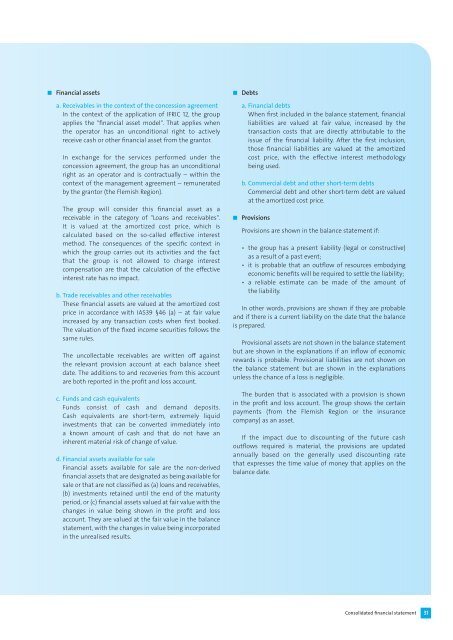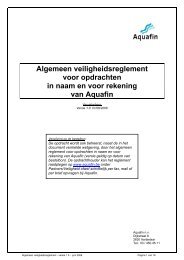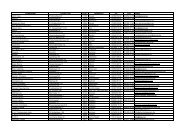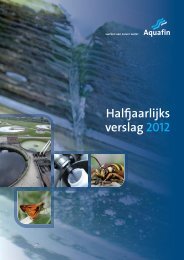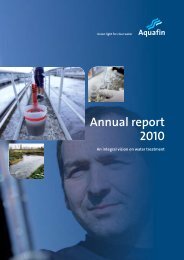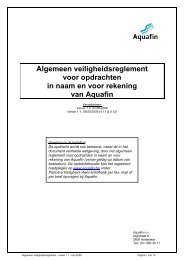Consolidated financial statement 2011 - Aquafin
Consolidated financial statement 2011 - Aquafin
Consolidated financial statement 2011 - Aquafin
Create successful ePaper yourself
Turn your PDF publications into a flip-book with our unique Google optimized e-Paper software.
n<br />
Financial assets<br />
n<br />
Debts<br />
a. Receivables in the context of the concession agreement<br />
In the context of the application of IFRIC 12, the group<br />
applies the "<strong>financial</strong> asset model". That applies when<br />
the operator has an unconditional right to actively<br />
receive cash or other <strong>financial</strong> asset from the grantor.<br />
In exchange for the services performed under the<br />
concession agreement, the group has an unconditional<br />
right as an operator and is contractually – within the<br />
context of the management agreement – remunerated<br />
by the grantor (the Flemish Region).<br />
The group will consider this <strong>financial</strong> asset as a<br />
receivable in the category of "Loans and receivables".<br />
It is valued at the amortized cost price, which is<br />
calculated based on the so-called effective interest<br />
method. The consequences of the specific context in<br />
which the group carries out its activities and the fact<br />
that the group is not allowed to charge interest<br />
compensation are that the calculation of the effective<br />
interest rate has no impact.<br />
b. Trade receivables and other receivables<br />
These <strong>financial</strong> assets are valued at the amortized cost<br />
price in accordance with IAS39 §46 (a) – at fair value<br />
increased by any transaction costs when first booked.<br />
The valuation of the fixed income securities follows the<br />
same rules.<br />
The uncollectable receivables are written off against<br />
the relevant provision account at each balance sheet<br />
date. The additions to and recoveries from this account<br />
are both reported in the profit and loss account.<br />
c. Funds and cash equivalents<br />
Funds consist of cash and demand deposits.<br />
Cash equivalents are short-term, extremely liquid<br />
investments that can be converted immediately into<br />
a known amount of cash and that do not have an<br />
inherent material risk of change of value.<br />
d. Financial assets available for sale<br />
Financial assets available for sale are the non-derived<br />
<strong>financial</strong> assets that are designated as being available for<br />
sale or that are not classified as (a) loans and receivables,<br />
(b) investments retained until the end of the maturity<br />
period, or (c) <strong>financial</strong> assets valued at fair value with the<br />
changes in value being shown in the profit and loss<br />
account. They are valued at the fair value in the balance<br />
<strong>statement</strong>, with the changes in value being incorporated<br />
in the unrealised results.<br />
n<br />
a. Financial debts<br />
When first included in the balance <strong>statement</strong>, <strong>financial</strong><br />
liabilities are valued at fair value, increased by the<br />
transaction costs that are directly attributable to the<br />
issue of the <strong>financial</strong> liability. After the first inclusion,<br />
those <strong>financial</strong> liabilities are valued at the amortized<br />
cost price, with the effective interest methodology<br />
being used.<br />
b. Commercial debt and other short-term debts<br />
Commercial debt and other short-term debt are valued<br />
at the amortized cost price.<br />
Provisions<br />
Provisions are shown in the balance <strong>statement</strong> if:<br />
• the group has a present liability (legal or constructive)<br />
as a result of a past event;<br />
• it is probable that an outflow of resources embodying<br />
economic benefits will be required to settle the liability;<br />
• a reliable estimate can be made of the amount of<br />
the liability.<br />
In other words, provisions are shown if they are probable<br />
and if there is a current liability on the date that the balance<br />
is prepared.<br />
Provisional assets are not shown in the balance <strong>statement</strong><br />
but are shown in the explanations if an inflow of economic<br />
rewards is probable. Provisional liabilities are not shown on<br />
the balance <strong>statement</strong> but are shown in the explanations<br />
unless the chance of a loss is negligible.<br />
The burden that is associated with a provision is shown<br />
in the profit and loss account. The group shows the certain<br />
payments (from the Flemish Region or the insurance<br />
company) as an asset.<br />
If the impact due to discounting of the future cash<br />
outflows required is material, the provisions are updated<br />
annually based on the generally used discounting rate<br />
that expresses the time value of money that applies on the<br />
balance date.<br />
<strong>Consolidated</strong> <strong>financial</strong> <strong>statement</strong><br />
31


